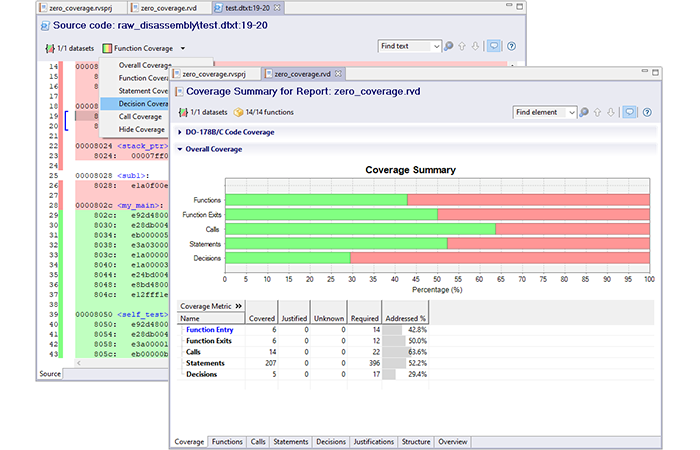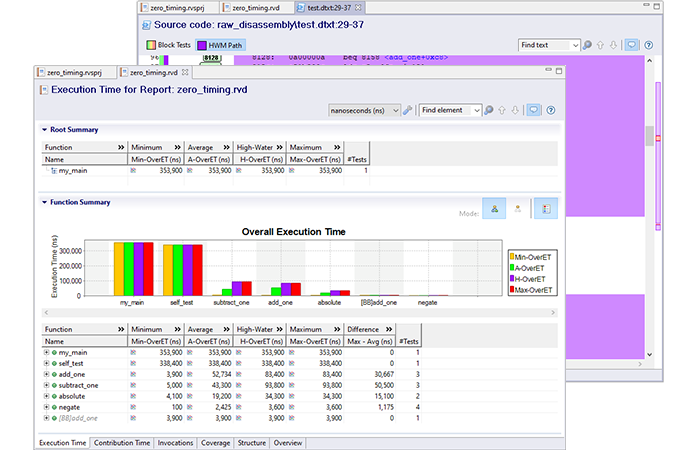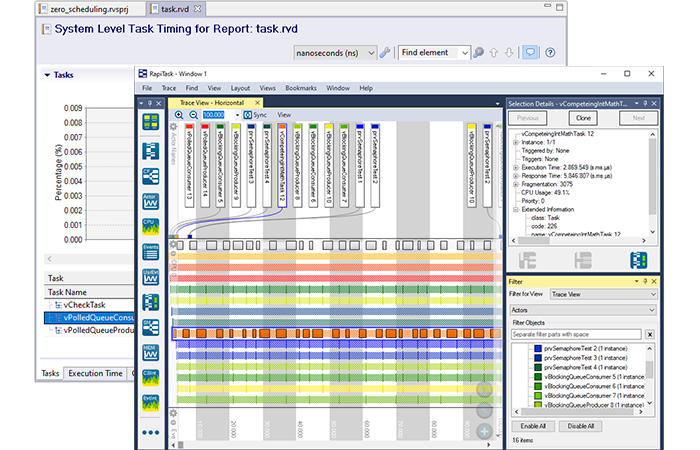RVS 3.12 introduces a zero-footprint analysis methodology, further reducing the effort needed to verify critical software
Zero-footprint coverage analysis
RapiCoverZero lets you analyze structural coverage from software tests directly from object code on compatible systems.
With no need for source code or modifications to your development environment, this supports coverage analysis up to and including decision coverage for third-party libraries and in projects with negligible target resources for instrumentation.
You can use RapiCoverZero either standalone or along with RapiCover. For more information on RapiCoverZero, see our product page.
Zero-footprint timing analysis
RapiTimeZero lets you analyze the timing behavior of critical software directly from object code on compatible systems.
Providing execution time metrics and identifying the high-water mark path in your code, RapiTimeZero requires neither source code nor modifications to your development environment, supporting timing analysis of third-party libraries and in projects with negligible target resources for instrumentation.
You can use RapiTimeZero either standalone or along with RapiTime. For more information on RapiTimeZero, see our product page.
Zero-footprint task-level scheduling analysis
RapiTaskZero lets you analyze the task-level scheduling behavior of critical software directly from object code on compatible systems.
RapiTaskZero provides a range of visualization options that help you understand scheduling behavior and identify rare timing events such as priority inversions with no need for source code or modifications to your development environment, supporting the analysis of third-party libraries and in projects with negligible target resources for instrumentation.
You can use RapiTaskZero either standalone or along with RapiTask. For more information on RapiTaskZero, see our product page.
Get started with RVS 3.12
More features

 Rapita System Announces New Distribution Partnership with COONTEC
Rapita System Announces New Distribution Partnership with COONTEC
 Rapita partners with Asterios Technologies to deliver solutions in multicore certification
Rapita partners with Asterios Technologies to deliver solutions in multicore certification
 SAIF Autonomy to use RVS to verify their groundbreaking AI platform
SAIF Autonomy to use RVS to verify their groundbreaking AI platform
 RVS gets a new timing analysis engine
RVS gets a new timing analysis engine
 How to measure stack usage through stack painting with RapiTest
How to measure stack usage through stack painting with RapiTest
 What does AMACC Rev B mean for multicore certification?
What does AMACC Rev B mean for multicore certification?
 How emulation can reduce avionics verification costs: Sim68020
How emulation can reduce avionics verification costs: Sim68020
 How to achieve multicore DO-178C certification with Rapita Systems
How to achieve multicore DO-178C certification with Rapita Systems
 How to achieve DO-178C certification with Rapita Systems
How to achieve DO-178C certification with Rapita Systems
 Certifying Unmanned Aircraft Systems
Certifying Unmanned Aircraft Systems
 DO-278A Guidance: Introduction to RTCA DO-278 approval
DO-278A Guidance: Introduction to RTCA DO-278 approval
 Avionics Certification Q&A: CERT TALK (with Consunova and Visure)
Avionics Certification Q&A: CERT TALK (with Consunova and Visure)
















